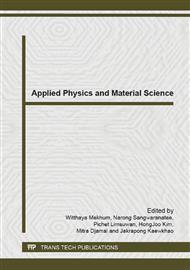p.417
p.421
p.426
p.431
p.435
p.440
p.444
p.448
p.455
Characterization of Calcium Hydroxide Derived from Waste Eggshell upon Moisture Effect
Abstract:
The structural transformations of chicken eggshell sample upon heat treatments and water absorption have been studied after having ground the shells into powders. Structural identifications of chicken eggshell samples were performed by using x-ray diffraction, IR spectroscopy and Energy Dispersive X-rays spectrometer (EDXRF). It was found that the specimen is made of calcite, a common phase of CaCO3 mineral. An then annealing at different temperatures in the range of 300-600C, The chicken eggshell not transformation, but after heat treatment at temperature 900C, the chicken eggshell sample have been transform structural in to oxide compound with calcia phase. In addition, the chicken eggshells have been preparation calcium hydroxide via a water steam route.
Info:
Periodical:
Pages:
435-439
Citation:
Online since:
June 2014
Authors:
Price:
Сopyright:
© 2014 Trans Tech Publications Ltd. All Rights Reserved
Share:
Citation:


